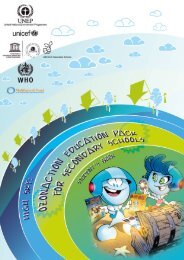Chapter 2. Progress towards the EFA goals - Unesco
Chapter 2. Progress towards the EFA goals - Unesco
Chapter 2. Progress towards the EFA goals - Unesco
You also want an ePaper? Increase the reach of your titles
YUMPU automatically turns print PDFs into web optimized ePapers that Google loves.
PROGRESS TOWARDS THE <strong>EFA</strong> GOALS<br />
Early childhood care and education<br />
quality of public care. Whatever <strong>the</strong> underlying<br />
causes of health disadvantage, <strong>the</strong> consequences<br />
include educational disadvantage later in life.<br />
The strength of <strong>the</strong> links between maternal health<br />
and education is often overlooked. Some of those<br />
links are very direct. Young women of middle to<br />
higher secondary school age, 15 to 19, account<br />
for one in seven deaths related to pregnancy and<br />
childbirth (WHO and UNICEF, 2003). The younger<br />
<strong>the</strong> age at pregnancy, <strong>the</strong> greater <strong>the</strong> health risks<br />
for mo<strong>the</strong>r and child. Being born to a mo<strong>the</strong>r<br />
under 18 increases <strong>the</strong> risk of infant mortality by<br />
60% and <strong>the</strong> children who survive are more likely<br />
to suffer from low birth weight, undernutrition and<br />
delayed cognitive development (Lawn et al., 2006;<br />
UNICEF, 2008b; WHO, 2005).<br />
Empowerment through education is one of <strong>the</strong><br />
strongest antidotes to maternal risk. Women with<br />
higher levels of education are more likely to delay<br />
and space out pregnancies, and to seek health<br />
care support. In South and West Asia, almost half<br />
of women with no education give birth without<br />
having received antenatal care, compared with<br />
nearly 10% for women with secondary education<br />
(Figure <strong>2.</strong>3). The ‘education advantage’ is even<br />
more pronounced when it comes to having a<br />
skilled birth attendant present during delivery.<br />
In Burkina Faso, mo<strong>the</strong>rs with primary education<br />
are twice as likely to have a skilled attendant<br />
present as those with no education, and women<br />
with secondary education are almost four times<br />
as likely. While <strong>the</strong> association between education<br />
and improved maternal and child indicators is<br />
not evidence of causation, <strong>the</strong> strength of <strong>the</strong><br />
association points to <strong>the</strong> importance of <strong>the</strong><br />
two-way link between investment in health<br />
and investment in education.<br />
Rapid progress is possible<br />
Slow progress <strong>towards</strong> international <strong>goals</strong> in<br />
areas such as maternal health, child nutrition<br />
and survival is sometimes viewed as evidence<br />
of <strong>the</strong> cost and complexity of effective measures.<br />
That assessment is flawed. Without understating<br />
<strong>the</strong> extent of <strong>the</strong> challenges, <strong>the</strong>re is compelling<br />
evidence that rapid progress is possible.<br />
Cost-effective measures that work include<br />
complementary feeding and vitamin<br />
supplementation, a continuum of care during<br />
pregnancy and childbirth, immunization and wider<br />
strategies to tackle killer diseases such as malaria<br />
and pneumonia (Black et al., 2008). To make such<br />
Figure <strong>2.</strong>3: Educated mo<strong>the</strong>rs have better access to antenatal care<br />
Children under age 3 born without antenatal care, by maternal education,<br />
South and West Asia and sub-Saharan Africa, circa 2005<br />
% of children under 3 born<br />
without antenatal care<br />
50<br />
40<br />
30<br />
20<br />
10<br />
0<br />
South and West Asia<br />
Sub-Saharan Africa<br />
Notes: Figures presented are population weighted averages. The sample of countries used to estimate<br />
<strong>the</strong> South and West Asia average represents more than 90% of <strong>the</strong> total population of <strong>the</strong> region and<br />
<strong>the</strong> sample used to estimate <strong>the</strong> sub-Saharan Africa average more than 80%.<br />
Source: Macro International Inc. (2009).<br />
interventions available, countries need affordable<br />
and accessible health systems, allied to wider<br />
measures for targeting vulnerable groups and<br />
combating malnutrition. Bad news tends to<br />
dominate <strong>the</strong> headlines, but <strong>the</strong>re is positive<br />
news too:<br />
Scaling up maternal and child health services.<br />
Experience from Bangladesh and Nepal shows<br />
that maternal and child survival can be improved<br />
in low-income settings by increasing access to<br />
skilled attendants, antenatal care and family<br />
planning advice (DFID, 2008b). In <strong>the</strong> United<br />
Republic of Tanzania, health spending has been<br />
increased and focused on diseases that affect<br />
<strong>the</strong> poorest districts. Coverage of key maternal<br />
and child health services has expanded, with<br />
a marked increase in <strong>the</strong> recruitment of<br />
community-based midwives and health workers.<br />
Child nutrition is improving, as reflected in a 40%<br />
decline in child mortality between 2000 and 2004<br />
(Masanja et al., 2008).<br />
Achieving results through aid. The GAVI Alliance<br />
(formerly Global Alliance for Vaccines and<br />
Immunisation), formed in 2000, has supported<br />
<strong>the</strong> immunization of 213 million children, saving<br />
an estimated 3.4 million lives. From 2000 to 2006,<br />
deaths from measles in Africa fell by 90% (GAVI<br />
Alliance, 2009a). International partnerships on<br />
HIV and AIDS have increased <strong>the</strong> share of HIVpositive<br />
pregnant women receiving antiretroviral<br />
<strong>the</strong>rapy from 15% to 33%, helping prevent<br />
transmission to children (Global Fund, 2008a).<br />
No education<br />
Primary<br />
Secondary or higher<br />
Regional average<br />
The links between<br />
maternal health<br />
and education are<br />
often overlooked<br />
47
















